
|
BTW: The Operating System Wars are officially over. Updated: Apple has won. Again |
The Portable DimRoom™ MacBook Air Where does it fit into the Digital Photographer's world—or does it at all? Every so often something comes along that rocks your world, or mine. The portable pro-level computer is an example of this, and our report on Apple's MacBook Pro laptops that follow this announcement certainly deserve a look, but now Apple has introduced the 3 pound (1.64 kg), 13-inch screen, super thin (it tapers from 0.76 inches to 0.16 inches, back to front) hyper-portable laptop designated the MacBook Air. The interior drive is small. 80GB at most, and it doesn't have a built-in disk burner. So what good is it? I gotta tell ya, lugging around the 5.4 pound (2.45 kg) MacBook Pro nearly cost me a shoulder in two recent overseas trips. I tend to be paranoid and carry the computer with me on assignment, so the idea of a lighter source of instant Photoshop is a welcome prospect. To be fair, for an extra hundred bucks, Apple will sell you an exceedingly portable SuperDrive for the MacBook Air, so backing up shots on CDs or DVDs on the go is not a hardship. I'll pack the SuperDrive among my undies, thwarting fastidious cat burglars, but the computer will stay in my kit bag with the cameras and lenses. New in this model is a carry-over from iPhone experiences. The large trackpad on the computer's face is something of a miniature graphics tablet. You can use multi-finger gestures to scroll, shrink, enlarge and even twist images on the computer screen. The keys are lit in the dark, and the impossibly thin screen is illuminated with LEDs, so one may expect long battery charge life (5 hours says Apple).
Lower in power, smaller by 60% and still a Core 2 Duo, the 1.6/1.8GHz chip has 4MB of L2 cache and runs with an 800MHz frontside bus. RAM is 2GB, so the machine is fast and Photoshop-ready. If you have the bread, you can get it with a 64GB solid state hard drive instead. When you haul out the top-end Nikon or Canon and start blazing away, people notice. They see the N- or C-word and give you some extra room. It's an image thing, and I didn't mean photographic. Rodney Dangerfield should have had a modern high-end DSLR. You know how you feel when you're dressed to the nines and everybody wants to be your friend? That's the image thing. Whip out this slab of impossible tech and you are instantly dressed to the nines, and everybody wants to be your friend. Now when you settle into Le Starbucks, a different image thing comes into play. Obviously that sleek little wafer thin slab in your lap is miles of technology more advanced than every other computer in the room, but where it really has a chance to sing is for your clients. Its screen resolution is 1280 x 800—enough to make images look impressive, and you can remotely control presentations on it with an Apple Remote ($19). Think of it this way, your client won't be unimpressed. If they fail to recognize you as being the coolest photographer in town, add 15% to their bill. Back in Your Studio, the Micro-DVI connector lets you run a full scale 23-inch Apple Cinema Display for 1920 x 1200 pixel views. It even has a camera built into the screen. Which begs an unanswered question: Who makes these 1.3MB cameras that are just 0.0 inches thick? And when is that idea coming to my DSLR? Downsides? Sure. It doesn't have a bigger screen. It isn't as fast as a MacBook Pro (mine's 2.4GHz, or presumably 33% faster (NB: bus speed figured in), cost ($1800), glossy screen only, no on-board CD reader, no firewire for digital video*, won't drive a 2560 x 1600 pixel Cinema Display 30-incher, no extra battery possible, 80 GB disk tops... Upsides? Small, light, fast enough for Photoshop's toughest problems and all of our iNovaFX Actions, full size keyboard—backlit, Airport (802.11n) at top speed, Bluetooth at top speed, runs external monitors up to 1920 x 1200, runs Windows Vista or XP, includes Leopard and iLife 08, could possibly expand your love life, becomes a Skype node or videophone when connected through wi fi, burns CD/DVDs on other Macs or PCs (software included) or via the $99 SuperDrive. MB Air 2.0? Think Later, Dude. 200GB SSD, BetterFasterCheaper. November? * USB 2.0 is as fast as it gets. We have not found a work-around for this, yet. Work Station To Go (and more) Light, Bright and Ultimate All At Once. (original Editorial; 02/06. Now up-rezed on 01/08/08.) The 15-incher is being loudly touted variously as the portable digital photographer's dream machine, the digital video editors porta-bay, and the fastest Vista portable out there. Wha? You heard me. With the right software, operating system and Microsoft Vista under its hood, the fast MacBook Pros are blowing the socks off the Windows-only machines. So says PCWorld. But what would they know? When Macs crossed the unwritten line between Motorola Power PC chips and became Intel chip-huggers, not only did they start running cooler, faster and longer, they instantly gained the upper hand over the farmer and his dell. And get this: Apple wasn't even TRYING to be the fastest PC machine out there. Dell, Toshiba, Alienware and Gateway all WERE. Bwaa ha ha ha. PCWorld called the MBP, the Ultimate Notebook. Anybody's Ultimate Notebook. Unix at the dual core, Mac OS (now Leopard) is able to run all the compatible Mac software, and three utilities can turn the same machine into wicked fast PC platforms while providing all that stuff you need to run Vista. Memory, graphics, hard disk space, etc. Apple's own Boot Camp lets you switch between Mac or PC OS at startup or reboot. Parallels (SW Soft) or Fusion (VM Ware) let you run Vista or Windows XP at the same time as Mac OS. This just in: A MBP with VMWare Fusion on board is faster than it has any reason to be--with Vista. Parallels is faster with Windows XP. The MacBook Pro 17-inch model can be ordered with a full HD screen (1920 x 1200 pixels, actually, so it's a tad larger than full HD) and that's where HD editors hang out. Same performance with Vista, though. With Adobe Creative Suite on board, Photoshop is on the go, and for bookies like me, InDesign and Acrobat sit there, as well. Now I can have my suite and eat it too. Good thing #2: MacBook Pros can run the 30-inch humungomonitor. Apple's 30-inch cinema display screen is a cord away from being slathered in pixels by the portables. So the inch-thick portaputer can sit on your business desktop acting as your workstation. [Q: Will the humungomonitor be improved on January 15 at MacWorld? In fact, by tests, the MBP in the speed range of my big under-the-desk Mac tower computer. Wholly cow!
Apple's operating system isn't something you can just shove into any old PC. Special proprietary chips (called a TPM module) are on the motherboard, and they move code around in unique ways. But if you build a computer from the ground up to accommodate the Apple OS and software, that same machine already has all the stuff that a PC needs--just sitting there, already on board. Where this leads is here: The November '07 Mac portable computers have 2.2 and 2.4 GHz Core 2 Duo T7700 Intel chips inside. [3/19/08: Now speed is up to 2.6GHz plus some faster bus speeds and a bigger, more clever touchpad.]
New with the Intel processors are four other design advances that will whet your whistle. It's as if they had the real-world work processes of professional photographers in mind at every step in the design stages.
You're a pro, right? You take your photography seriously and you need to use the computer screen to communicate with clients, customers, buyers, art directors, board members, patrons or staff. If you already have one of these big screen displays, you already know how much of a life-changing picture window into the universe of digital photography it is. If you don't have one of these, your competitor does, or will, leaving you in the unenviable position of having to play catch-up. Budget it into your business plan--it's the smartest thing you can do. When you sit your paying customer in front of one of these screens and feed it with his or her images at a resolution and scale that makes judging, viewing, deciding and altering images into a close match to human-scale, brain-relaxing, ergonomically-appropriate, intuitive interaction, you've done them and yourself a huge favor. Anybody who looks at one of these giant screens and says they're a "luxury" and not a necessity is somebody whose decision process you'd better question across the board. That person isn't hip, on the boat, aware of visual processes or someone you need making business decisions for you. Stand in front of the mirror and practice saying, "So, the 30-inch screen is a toy, eh? You're fired." And mean it. Yes, it's expensive. Yes, the 23-inch (1920 x 1200 pixels) is much less expensive (half) and is appropriate for enthusiast photographers and second screens, but you won't get the "woo" factor from your clients with it. Yes, there's a sixth item of interest in the MacBook Pros--the built-in iSight camera. Your computer plus a Starbucks with a Wi-Fi node equals videophone anywhere in the world. No extra gear to pack. Yeah, sure, you can get a laptop with the Intel chips on board for cheaper. No bright screen, no iSight camera, no OSX, no suite of added programs, no possibility of Keynote and no hookup to the 30-inch screen back in your office, but hey, you saved a few bucks. Use the spare change to buy back the missing items your bargain box lacked--whoops, no can do.
Consider this strategy (revealed in greater detail in the DSLR: Nikon D200, DSLR: Nikon D80 and DSLR: Nikon D40/D40x eBooks): You're shooting digital and your client is breathing down your neck. What do you do? You whip out your laptop. (That dim Dell or that Sizzling MacBook Pro? Your call.) On the road your laptop is your best feet forward, and maybe you use the vertical display trick that Nefertiti liked so much, in concert with Keynote software and your handy remote control to make the whole court go ooo and aah. Then, back in the office, you dump the images into your workstation and complete the assignment. If you had the MacBook Pro, you simply hooked up a cord and viewed its contents on the 30-inch screen, because you had the workstation with you all along. This will get you started while looking like the professional you really are, even though you have only spent six grand on the non-camera side of your workflow. B'b'but what if the portable workstation gets stolen? You were burning data DVDs all along, weren't you?
You will have your own opinions about gear. Certainly I have mine. If you are a Microsoft devotee and don't wish to hear from people who have both, good night, and good luck. Technical solutions are out there that will hook up those Apple Cinema Display screens to your PC, or just get the Dell, and good on ya. If you are on the fence about your professional evolution, the portable super screen in concert with the office super screen is something you need to investigate further. I'm real picky about who to believe when opinions and advice are being slung around, and you should be, too. Even when the slinger is yours truly.
Apple Loose Predictions: (2/06) And Answers as of 1/08/08 or 3/19/08. These are not guesses. This is EXACTLY how the Universe will flow over the next time period. By Summer '07 Apple's share will be about 8-9% total, up from today's 6.3% of market share and nearly triple their share from 2002. By Winter '08, it will have entered double digits. The stampede will have started. Smaller PC makers will desperately sell their single-OS machines at deep discounts but many won't survive the blood bath. Time magazine will feature Steve Jobs as Man of the Year. It has come true. Sort of. Time's award is still up for grabs, but the Apple iPhone is the clear winner of the Machine Of The Year. And Apple's market share has been growing, and growing, and growing while Vista has been cringing and cringing and cringing. [3/19/08: Just to confuse things, recent industry analyists are now saying that Apple's market share of new computer sales in units is 14% and in dollars has risen to 25%.]
Sold over a million in a month. Five million in six months. On target for their 10 million Year One prediction. In 2008, a version will actually migrate to the wrist--and to the Oakleys for heads up displays. PC-only motherboards for hobbiest builders will cross the $10 line. (I made that up.) Apple's lawsuit for copyright and design infringement and plagiarism will win first in Europe and then move to Asia and the US. Delaying tactics will bleed Microsoft to the edge, but not their lawyers. Yet to happen. In Europe the popular rally cry will tie the borrowing of features, feel, theft, plagiarism and copying of designs and functions appearing in Vista to the more easily pronounced pan-linguistic, broader term "pirate" and every sentence spoken by anyone at Microsoft that features Pirate or Piracy will be greeted with howls of laughter.
Time magazine will feature Bill Gates Yet to happen. Bill is more correctly referred to as "Richest Pirate of the Year." By 2012, Microsoft, at a developmental write-off cost of 236 billion dollars, will introduce Vista NX which will be finally regarded as a worthy competitor to OS X Lion, which will have appeared in early 2010, two months ahead of schedule. Three days later, Apple will release OS X Kitty. Microsoft's share will have dwindled to 36%. Still slightly ahead of twin competitors Apple and Linux. Is it inertia or is it momentum? Yet to happen. In 2015 Google will buy Apple for 1.6 trillion dollars. Yet to happen. Copy poc? Drivel? Have you driven a Ford, lately? See y'all on Y'all Tube. Just One More Thing...
Apple's high-end image organizing, processing and client-interacting program for professional photographers. Now this program has became Version 2 and price is only $299, a reduction of 40% from its introductory $499. Bon Aperture! As of February 08, it has grown into Version 2 with a number of work-flow improvements, and street prices can be found from reputable Web-order sources for as little as $260 US. Let me know if you find it for less and I'll update this page. -iNova * Disclosure: I own some Apple stock. So none of this is anything more than a feeble attempt to boost the share price, right? Or... Did I buy the Apple stock after slogging through things my PC gear revealed to me in a dream? A dark, nasty dream rife with sweat, frustration and vir... &%$@#kG?ºª§¶£¢¡≠≠“‘«π∂©≈√∫ıDΟ‡fi- |
|
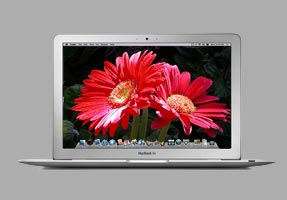 1 16 08 / 3 19 08
1 16 08 / 3 19 08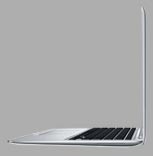 To make this machine possible, Apple had to get Intel to make them a new processor to their unique specifications. Not a whole new thing, but a smaller package with their best twin core porta-processor.
To make this machine possible, Apple had to get Intel to make them a new processor to their unique specifications. Not a whole new thing, but a smaller package with their best twin core porta-processor.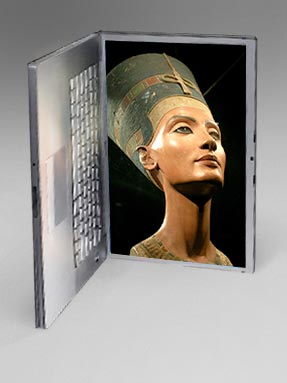
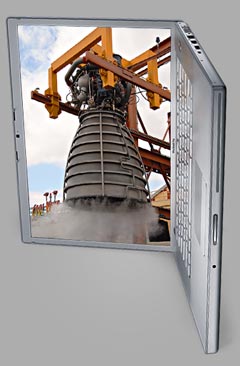 #1: The 1440 x 900 pixel screen screams with LED illumination. Major Bonus: Here's a computer that moves out of the darkroom, out of the dim room and into the bright environments of the window office with impunity. Showing what you are doing: A computer's foremost task.
#1: The 1440 x 900 pixel screen screams with LED illumination. Major Bonus: Here's a computer that moves out of the darkroom, out of the dim room and into the bright environments of the window office with impunity. Showing what you are doing: A computer's foremost task.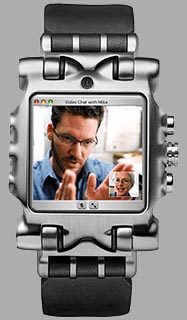 Apple's iPhone--think Dick Tracy's two-way wrist TV--introduced in 07 will bring millions of PC users to the OS X camp where kids will talk through iGaggle, with its integrated iCU/UCwi video phone interaction.
Apple's iPhone--think Dick Tracy's two-way wrist TV--introduced in 07 will bring millions of PC users to the OS X camp where kids will talk through iGaggle, with its integrated iCU/UCwi video phone interaction. 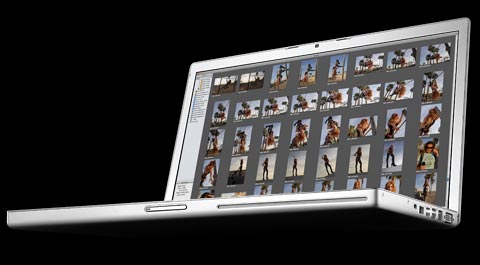 Jay Leno and simlar-minded wanks will only have to say the P word to start the audience rolling.
Jay Leno and simlar-minded wanks will only have to say the P word to start the audience rolling. 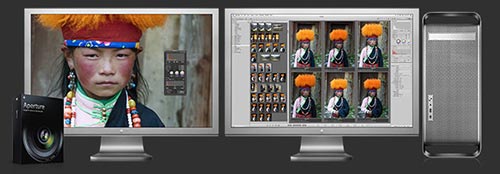 Let me infect you with a professional bug in your ear:
Let me infect you with a professional bug in your ear: